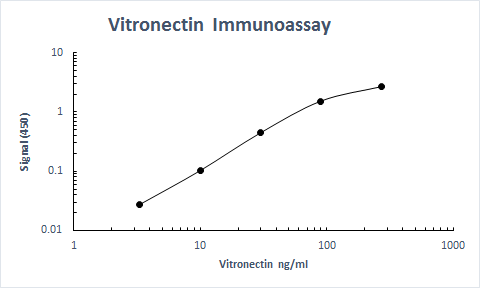Human Vitronectin Antibody Summary
*Small pack size (-SP) is supplied either lyophilized or as a 0.2 µm filtered solution in PBS.
Applications
Please Note: Optimal dilutions should be determined by each laboratory for each application. General Protocols are available in the Technical Information section on our website.
Scientific Data
 View Larger
View Larger
Detection of Human Vitronectin by Western Blot. Western blot shows lysates of HepG2 human hepatocellular carcinoma cell line and human liver tissue. PVDF membrane was probed with 1 µg/mL of Goat Anti-Human Vitronectin Antigen Affinity-purified Polyclonal Antibody (Catalog # AF2349) followed by HRP-conjugated Anti-Goat IgG Secondary Antibody (Catalog # HAF017). A specific band was detected for Vitronectin at approximately 65-70 kDa (as indicated). This experiment was conducted under reducing conditions and using Immunoblot Buffer Group 1.
 View Larger
View Larger
Vitronectin in Human Bladder. Vitronectin was detected in immersion fixed paraffin-embedded sections of human bladder using Goat Anti-Human Vitronectin Antigen Affinity-purified Polyclonal Antibody (Catalog # AF2349) at 3 µg/mL overnight at 4 °C. Before incubation with the primary antibody, tissue was subjected to heat-induced epitope retrieval using Antigen Retrieval Reagent-Basic (Catalog # CTS013). Tissue was stained using the Anti-Goat HRP-DAB Cell & Tissue Staining Kit (brown; Catalog # CTS008) and counterstained with hematoxylin (blue). Specific staining was localized to extracellular matrix. View our protocol for Chromogenic IHC Staining of Paraffin-embedded Tissue Sections.
 View Larger
View Larger
Detection of Human Vitronectin by Simple WesternTM. Simple Western lane view shows human serum, loaded at a 1:300 dilution. A specific band was detected for Vitronectin at approximately 76 kDa (as indicated) using 1 µg/mL of Goat Anti-Human Vitronectin Antigen Affinity-purified Polyclonal Antibody (Catalog # AF2349) followed by 1:50 dilution of HRP-conjugated Anti-Goat IgG Secondary Antibody (Catalog # HAF109). This experiment was conducted under reducing conditions and using the 12-230 kDa separation system.
Reconstitution Calculator
Preparation and Storage
Background: Vitronectin
VN/Vitronectin (vitro-nectin: Latin for "glass" and "to bind to", respectively) is a 65-78 kDa circulating glycoprotein that was initially named for to its ability to 1) bind to glass beads, and 2) attach to cell membranes. Also known as somatomedin-B and Serum Spreading Factor, vitronectin is a matricellular protein that belongs to a group of RGD-type adhesive molecules. It is secreted by hepatocytes and circulates as a monomer/homodimer. Upon binding to ECM or PIA-1, it oligomerizes and becomes active. VN acts as a promoter of cell migration and ECM remodeling. It does so by binding to HSPG in the ECM which exposes binding sites for integrins and uPAR on cells. In this context, VN allows for the formation of a uPAR:soluble uPAR:uPA complex that results in the proteolysis of pericellular matrix and subsequent cell migration. Vitronectin also serves as a receptor for circulating PAI-1. When bound, VN forms oligomers that facilitate subsequent binding to vimentin, a cellular intermediate filament. The vimentin:VN:PAI-1 complex is active, and blocks the enzymatic degradation of vascular clots. Human secreted vitronectin is a 459 amino acid (aa) glycoprotein. It can exist as either a 77-78 kDa monomer, or an internal disulfide-linked 65 kDa:10 kDa heterodimer that arises from proteolytic cleavage between Ala398Thr399. VN has multiple domains, including a somatomedin B domain that binds uPAR and PAI-1 (aa 1-40), an RGD motif (aa 64-66) and a heparin-binding region (aa 340-380). VN is sulfated, N- and O-glycosylated, and phosphorylated on at least five Thr/Ser based sites. Over aa 20-29 (i.e.‑DQESCKGRCT), human and mouse VN are identical in their amino acid sequences.
Product Datasheets
FAQs
No product specific FAQs exist for this product, however you may
View all Antibody FAQsReviews for Human Vitronectin Antibody
Average Rating: 5 (Based on 1 Review)
Have you used Human Vitronectin Antibody?
Submit a review and receive an Amazon gift card.
$25/€18/£15/$25CAN/¥75 Yuan/¥1250 Yen for a review with an image
$10/€7/£6/$10 CAD/¥70 Yuan/¥1110 Yen for a review without an image
Filter by:


